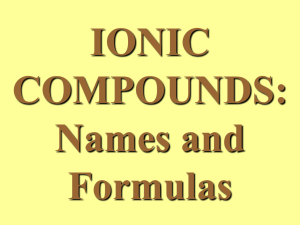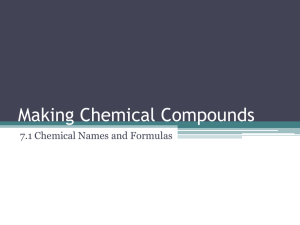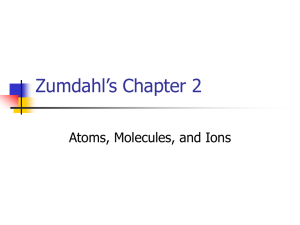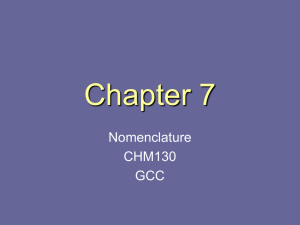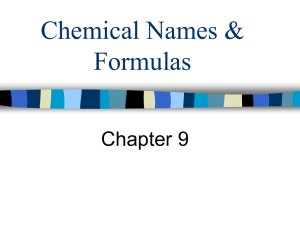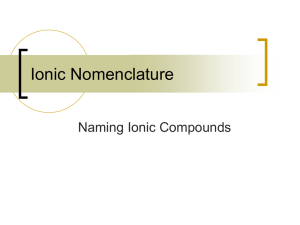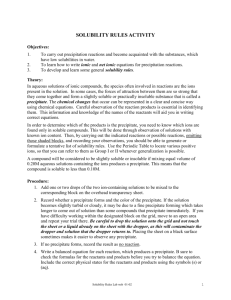IONIC COMPOUNDS
advertisement
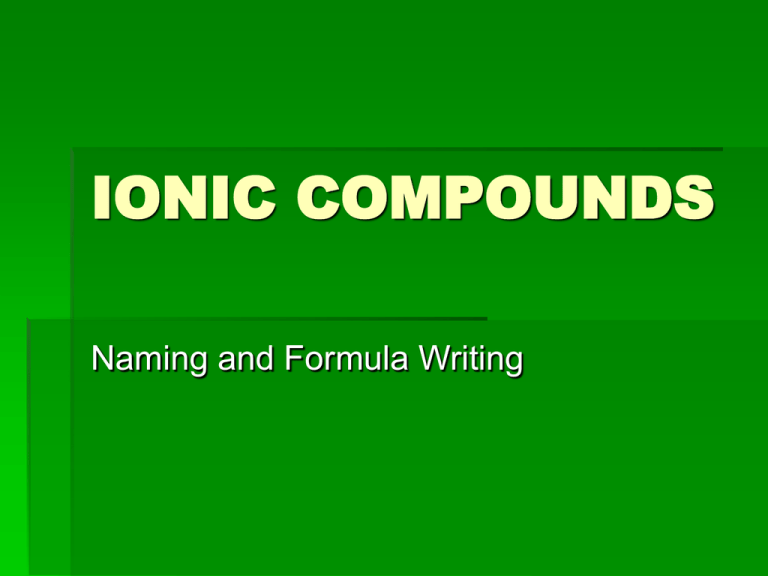
IONIC COMPOUNDS Naming and Formula Writing OBJECTIVES: Apply the rules for naming and writing formulas for binary ionic compounds. Apply the rules for naming and writing formulas for compounds containing polyatomic ions. Predicting Charges on Monatomic Ions KNOW THESE !!!! +1 +2 -3 -2 -1 Cd+2 0 Naming Positive Ions Before you name an Ion you have to know the charge. Group 1 = always +1 Group 2 = always +2 Aluminum = always +3 Zinc and Cadmium = always +2 Silver = always +1 The Other Metals All other metals can have various positive charges from +1 to +7 Roman Numerals are used to tell the charge Monatomic Ions Naming Postive Ions With group 1, 2, Al, Zn, Cd, and Ag you just give the name of the atom Na+ is Sodium Mg+2 is Magnesium Ag+ is Silver Al+3 is Aluminum All the other metals With all other metals you give the name Metal followed by a roman numeral Cu+ - Copper (I) Cu+2 – Copper (II) Fe+2 – Iron (II) Fe+3 – Iron (III) U+6 – Uranium (VI) Naming negative ions All negative ions have their endings changed to –ide Oxygen becomes oxide Fluorine becomes Fluoride Nitrogen becomes Nitride Chlorine becomes Chloride Names of other Negative Ions Carbide = what you want your parents to do for you Boride = what happened at the rodeo Silicide = what you are seeing right now Fluoride = a state in the union Iodide = Very sad, I guess we will have to Barium. Telleride = Telling the driver where you want to go Formulas of Ionic Compounds Formulas of ionic compounds are determined from the charges on the ions atoms Na + ions F : sodium + fluorine Charge balance: Na+ – : F : NaF sodium fluoride 1+ 1- formula = 0 Writing a Formula Write the formula for the ionic compound that will form between Ba2+ and Cl. To cancel out Ba’s +2, then two -1 Cl’s are needed. Solution: 1. Balance charge with + and – ions 2. Write the positive ion of metal first, and the negative ion Ba2+ Cl Cl 3. Write the number of ions needed as subscripts BaCl2 Balancing a formula by math Every ionic compound should have a formula that has a charge that equals zero. Barium Fluoride Ba+2 FHow many F’s are needed to balance Ba+2 ? Two Formula is BaF2 Another way – Drop, Swap, Reduce Aluminum Oxide Al is always +3 Oxide is always -2 Al+3, O-2 DROP: Al3O2 SWAP: Al2O3 REDUCE: 2 and 3 are lowest integers, so leave alone Another example Magnesium Oxide Mg is +2 Oxide is -2 Mg+2, O-2 DROP: Mg2O2 SWAP: Mg2O2 REDUCE: MgO, 2 and 2 divide each other out. Barium phosphide Barium will form Ba2+ Phosphorus will form P3 Formula is Ba3P2 Sodium sulfide Sodium will form Na+ Sulfur will form S2 Formula is Na2S Calcium chloride Calcium will form Ca2+ Chlorine will form Cl1 Formula is CaCl2 Complete in your journal Learning Check Write the correct formula for the compounds containing the following ions: 1. Na+, S2a) NaS b) Na2S c) NaS2 2. Al3+, Cla) AlCl3 b) AlCl c) Al3Cl 3. Mg2+, N3a) MgN b) Mg2N3 c) Mg3N2 Naming Compounds Binary Ionic Compounds: 1. Cation first, then anion 2. Monatomic cation = name of the element Ca2+ = calcium ion 3. Monatomic anion = root + -ide Cl = chloride CaCl2 = calcium chloride Naming Binary Ionic Compounds Examples: NaCl sodium chloride ZnI2 zinc iodide Al2O3 aluminum oxide Complete in your journal Learning Check Complete the names of the following binary compounds: Na3N sodium ________________ KBr potassium ________________ Al2O3 aluminum ________________ MgS _________________________ Transition Metals Elements that can have more than one possible charge MUST have a Roman Numeral to indicate the charge on the individual ion. 1+ or 2+ 2+ or 3+ Cu+, Cu2+ copper(I) ion copper (II) ion Fe2+, Fe3+ iron(II) ion iron(III) ion Names of Variable Ions These elements REQUIRE Roman Numerals because they can have more than one possible charge: anything except Group 1A, 2A, Ag, Zn, Cd, and Al (You should already know the charges on these!) Or another way to say it is: Transition metals and the metals in groups 4A and 5A (except Ag, Zn, Cd, and Al) require a Roman Numeral. FeCl3 CuCl SnF4 PbCl2 Fe2S3 (Fe3+) iron (III) chloride (Cu+ ) copper (I) chloride (Sn4+) tin (IV) fluoride (Pb2+) lead (II) chloride (Fe3+) iron (III) sulfide Examples of Older Names of Cations formed from Transition Metals (you do not have to memorize these) Complete in your journal Learning Check Complete the names of the following binary compounds with variable metal ions: FeBr2 iron (_____) bromide CuCl copper (_____) chloride SnO2 ___(_____ ) ______________ Fe2O3 ________________________ Hg2S ________________________ Polyatomic Ions Some ions are composed of more then one atom. These are called polyatomic ions Poly = more Formulas and names Nitrate = NO3 Sulfate = SO4-2 Silver nitrate Ag+ NO3 DSR = AgNO3 Copper (I) Sulfate Cu+ SO4-2 Cu2SO4 More Polyatomics Lead (IV) Phosphate Pb+4 PO4-3 Pb3(PO4)4 Notice: When more then one Polyatomic is present you surround it with () Big: The subscripts on Polyatomic ions are NEVER changed. Complete in your journal Learning Check Write the correct formula for the compounds containing the following ions: 1. Na+, PO4-3 a) NaPO4 b) Na2PO4 c) Na3PO4 2. Al3+, NO3a) Al(NO3)3 b) AlNO3 c) Al3NO3 3. NH4+, N3a) NH4N b) NH4N c) (NH4)3N Polyatomic Ions you have to know NAME Acetate FORMULA C2H3O-1 Carbonate Chlorate CO3-2 ClO3-1 Cyanide Hydroxide CN-1 OH-1 Nitrate NO3-1 Peroxide O2-2 Phosphate PO4-3 Sulfate SO4-2 Ammonium NH4+1 More on Polyatomics Most polyatomic ions end in –ate. The ending –ite means one less oxygen is present then in the ending –ate. Example: Nitrate versus Nitrite: NO3NO2 NOTICE: Only the number of O’s changed, not the charge. Even More The Prefix Hypo means two less oxygen’s are present then in –ate. Example: Hyposulfite: SO2-2 The Prefix Per- means one extra oxygen is present then in –ate. Examples: Perchlorate ClO4 Chlorate ClO3 Chlorite ClO2 HypoChlorite ClO- What if Hydrogen is in it? The Prefix Bi means that a Hydrogen is added, and the charge is reduced by one. Example: BiCarbonate HCO3-1 May also go by Hydrogen Carbonate. Practice by writing the formula or name as required… Iron (II) Phosphate Stannous Fluoride Potassium Sulfide Ammonium Chromate MgSO4 Complete in your journal FeCl3 Learning Check Match each set with the correct name: A. Na2CO3 1) magnesium sulfite MgSO3 2) magnesium sulfate MgSO4 3) sodium carbonate B. Ca(HCO3)2 1) calcium carbonate CaCO3 2) calcium phosphate Ca3(PO4)2 3) calcium bicarbonate Complete in your journal Learning Check A. aluminum nitrate 1) AlNO3 2) Al(NO)3 3) Al(NO3)3 B. copper(II) nitrate 1) CuNO3 2) Cu(NO3)2 3) Cu2(NO3) C. Iron (III) hydroxide 1) FeOH 2) Fe3OH 3) Fe(OH)3 D. Tin(IV) hydroxide 1) Sn(OH)4 2) Sn(OH)2 3) Sn4(OH) Complete in your journal Things to look for: 1) If cations have ( ), the number in parenthesis is their charge. 2) If anions end in -ide they are probably off the periodic table (Monoatomic) 3) If anion ends in -ate or –ite, then it is polyatomic Write the opposite of what is shown; If name shown, write formula; If formula shown, write name. 1. aluminum sulfide 11. Na2S 2. barium arsenate 12. K2SO4 3. copper (I) nitride 13. LiF 4. ammonium phosphate 14. Zn(NO3)2 5. lead (IV) nitrate 15. FeCl3 6. lithium oxalate 16. CaCO3 7. calcium bicarbonate 17. AlBr3 8. silver permanganate 18. Mg(NO3)2 9. mercury (I) bromide 19. FeSO4 10.chromium (III) sulfite 20. Pb(NO3)2




